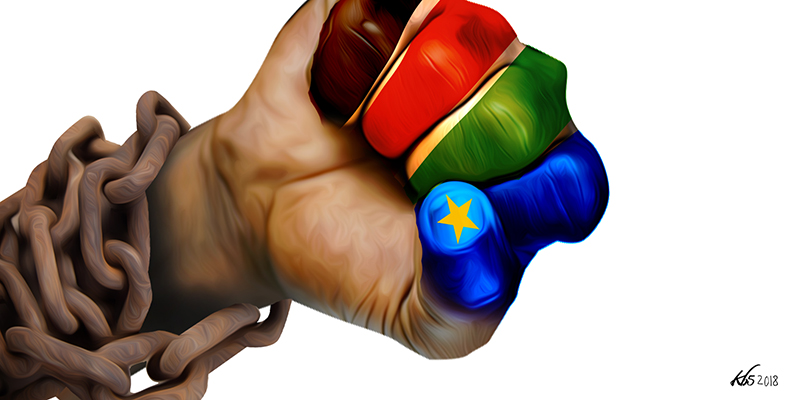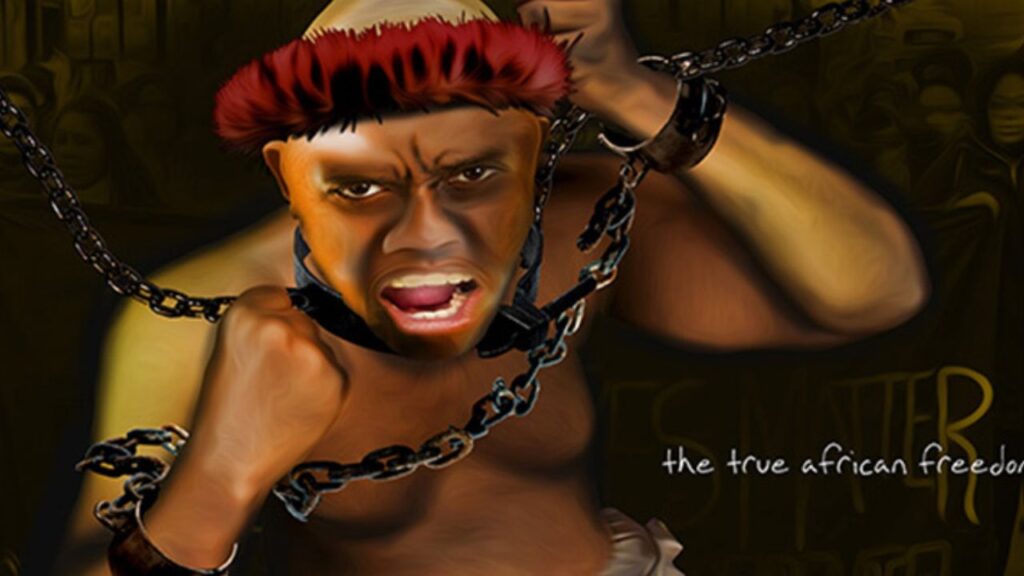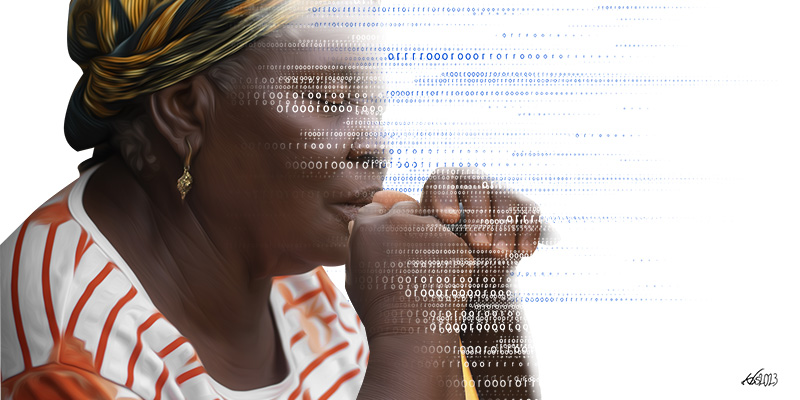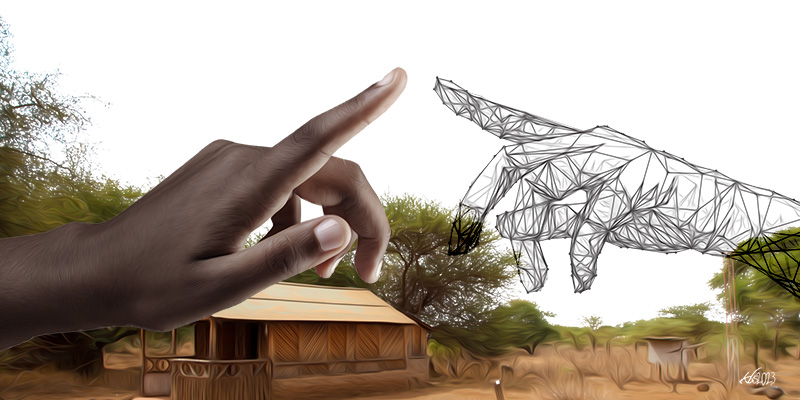The Sudan People’s Liberation Movement/Army (SPLM/A), a southern Sudan-based national liberation movement, sprouted in 1983 in the Sudanese and regional political theatre at the height of the Cold War that witnessed ideological and superpower rivalry in the Horn of Africa and the Middle East. Many South Sudanese and people on the political left received its declared objective of constructing a united socialist “new Sudan” with a pinch of salt. A handful of highly educated individuals formed its officer corps but the bulk of the army, the SPLA, was drawn not from an industrial working class but from sedentary and agro-pastoral communities – unlikely material for building socialism.
However, the united socialist new Sudan disappeared imperceptibly from the SPLM/A written and oral literature with the collapse of the Soviet Union and the world socialist system before the turn of the century. This led to an ideological shift in the SPLM/A system. This shift coincided with the demand by the people of South Sudan to exercise their inalienable right to self-determination.
The war of national liberation ended in a political compromise: the comprehensive peace agreement (CPA), which the SPLM and National Congress Party (NCP), representing the government of Sudan, spent eleven years negotiating in Nairobi, Machakos and finally Naivasha under the auspices of two successive Kenyan presidents. Dr. John Garang de Mabior and Sudan’s Vice President Ustaz Ali Osman Mohammed Tah signed the peace agreement in Nairobi on 9 January 2005 in a colourful ceremony presided over by President Mwai Kibaki of Kenya and witnessed by President Yoweri Museveni of Uganda, Meles Zenawi of Ethiopia, President Omar al Bashir of Sudan and Colin Powell, the US Secretary of State, among other African and world leaders.
In the second edition of “The politics of liberation in South Sudan: An insider’s view”, I posed the question: “What is the SPLM and where is it?” I was trying to provoke a debate in the SPLM/A that had since 1983 evolved like Siamese twins who are conjoined at the head and who cannot be separated surgically because it would lead to their death. There was no clear separation of functions with the SPLA being the military organ of the liberation movement and SPLM its political organ. The two subsumed and eclipsed each other’s respective functions, blurring and indeed distorting internal political and democratic development to prevent the emergence of a genuine and authentic national liberation movement.
The lack of an ideology and the absence of organisation and institutions in a national liberation movement can negatively influence its development and the relationship between its members and the masses of the people, as well as the nature of the resultant state. The state in South Sudan, in its current disposition regardless of the international recognition it obtains, is a façade. The lack of political organisation and the absence of democratic institutions and instruments of public power resulted in the personalisation of the SPLM/A’s power and public authority. These were the principal drivers of the internal contradictions, splits and factionalism within the SPLM/A.
The SPLM/A was such an informality that only Garang could manage it and keep it moving. His sudden demise in 2005 released the negative forces hitherto kept under tight lid by military authoritarianism. The power transfer to Commander Salva Kiir Mayardit went without a glitch. Nevertheless, Kiir’s leadership style, unlike that of Garang, enabled the emergence of “power-centres” around his presidency of the Government of South Sudan. The interim period, before the carrying out of the referendum on self-determination, witnessed internal power struggles among the SPLM’s first and second line leaders characterised by intrigues, short-changing and an upsurge in ethnic nationalism, as well as the emergence of ethnic associations and caucuses in the executive and legislative branches of government, widespread corruption in government and society, insecurity in the form of ubiquitous ethnic conflicts and localised civil wars.
The state in South Sudan, in its current disposition regardless of the international recognition it obtains, is a façade. The lack of political organisation and the absence of democratic institutions and instruments of public power resulted in the personalisation of the SPLM/A’s power and public authority. These were the principal drivers of the internal contradictions, splits and factionalism within the SPLM/A.
The independence of South Sudan found the SPLM (South Sudan’s governing party) in a state of acute dysfunctionality due to internal power wrangles. The leaders miserably failed to separate and transform the SPLM into a mass political party guided by democratic principles, a constitution and a political programme. Its internal situation was toxic and ready to implode. The pressure lid that tightly compressed its internal contradictions had suddenly ruptured with the death of Garang. It was only the general concern about secession from the Sudan among the majority of the Southern Sudanese that sustained the unstable calm, enabling the orderly conduct of the referendum on self-determination.
The structural drivers of SPLM/A internal splits
The internal and external socio-political conditions under which the SPLM/A formed in July 1983 laid the foundations of its perpetual internal instability. Without going into details, the failure to unify the remnants of the mutinies of elements of Sudan Armed Forces (SAF) in Bor (16 May) and Ayod (6 June) with the Anya-nya 2, which was formed by former officers and soldiers of Anya-nya, who had been absorbed into the SAF following the 1972 Addis Ababa Agreement and who rebelled in Akobo in February 1976, through the agency of the Derg defined the militarist character of the nascent movement. When the Anya-nya 2 flipped back to the liberation movement in 1988, no structural changes had occurred within the SPLM/A, particularly at the leadership level. Like a dinosaur, the SPLM had a tiny head resting on a huge body that it carried with immense difficulty. The suffocating military environment resulted in the 1991 Nasir Declaration that split the movement, leading to internecine fighting along ethnic contours. By the end of 2003, when Dr. Riek Machar and Dr. Lam Akol, who had authored the declaration, returned to the fold, the SPLM/A remained structurally unchanged.
The institutions created by the SPLM First National Convention in 1994, like the National Liberation Council (NLC) that was established to perform legislative functions and the National Executive Committee (NEC) that was to exercise executive functions of the SPLM/A, had disappeared into oblivion. The SPLM/A power and public authority had begun to centralise, concentrate and personify in Garang, its Chairman and Commander-in-Chief. The return to the SPLM/A of Machar and Akol on the eve of the peace agreement with Khartoum, coupled with Machar’s ambition to become Number One in the SPLM/A hierarchy, heightened rumour-mongering in the SPLM/A targeted at ousting of Salva Kiir as the deputy Chairman and SPLA’s Chief of General Staff. Kiir, who had stayed loyal to Garang throughout the turbulent years, would not take the rumours lying down. This triggered what came to be known in the SPLM/A as the Yei Crisis, which in November 2004 pitted Kiir against his boss.
Although the Yei crisis was an internal, structurally-driven SPLM/A matter, its ethnic overtones and provincial contours were prominent, feeding into a general dissatisfaction with Garang in Bahr el Ghazal (where he had in the course of time differed, split with and executed several leaders) spearheaded by prominent individuals linked to the National Islamic Front regime in Khartoum. A conference called in Rumbek to resolve this crisis, which addressed only its symptoms but not its structural underpinnings. This conference was typical of the SPLM/A meetings that always ended up fudging the substantive issues under the canopy of “opening a new page”. As a result, the attempts to resolve the crisis were frustrated, creating conditions for the resurgence or eruption of another crisis along the same lines.
Kiir, who had stayed loyal to Garang throughout the turbulent years, would not take the rumours lying down. This triggered what came to be known in the SPLM/A as the Yei Crisis, which in November 2004 pitted Kiir against his boss.
The splits in the SPLM/A have always been more political and personal than ideological, hence they transcended and permeated into the ethnic and provincial domains, acquiring different dimensions and dynamics. The splits in 1983/4 and 1991 quickly acquired ethnic dimensions because of the lack of an ideologically-driven agenda, although the commanders in Nasir had raised the right of the people of southern Sudan to exercise self-determination. However, the question of power and who wielded it was the common denominator in all these splits. It was the perception of power as a personal birthright rather than an institutional assignment that set the patterns for achieving it. In a militarist environment like the SPLM/A, the pattern for capturing and holding onto power was inevitably violent.
The SPLM split and the civil war
In the absence of democratic institutions and instruments of power and public authority, the SPLM/A became a huge informal patrimonial network of political patronage. This system became more pronounced after Garang’s death, the rise of Kiir within the SPLM/A and the independence of South Sudan. The lack of a political programme to manage the social and economic development of the new state of South Sudan rendered the interim period (2005-2011) what the SPLM leaders cynically called “payback time”: they dolled themselves up in self-aggrandisement, thanks to the easy availability of oil revenues. The nexus between personal power and wealth accumulated in a primitive fashion without consideration for law and order resulted in a life and death situation.
The patrimonial political patronage system that the SPLM leaders controlled accentuated and amplified the SPLM’s internal contradictions. The personalised power struggle became a fireball in December 2013, barely three years into the independence and birth of the Republic of South Sudan. The resultant civil war was initially viewed by many people as a war between Kiir and Machar (and by extension a war between the Dinka and the Nuer) but it was in fact a reflection of the SPLM’s failure to address its structurally-driven internal political contradictions.
The SPLM reunification
In all these SPLM/A disruptions, eruptions or implosions, these contradictions have always been buried under the talk about “return to the fold” or “reconciliation and peace”, which have left these contradictions intact and ready to rekindle. In December 2013, the eruption of violence, and its scale and ferocity, caught the IGAD region and the whole world unawares. South Sudan had not completely emerged from the effects of the 21-year war of liberation and from the border war with the Sudan (2012) and so nobody could understand why a people who had endured suffering for that long would go to war again. Thus, the interventions to help resolve the conflict were frenetic but superficial. Nobody cared to solicit a scientific understanding of the conflict’s causes.
The extraordinary summit of IGAD Heads of State and Government, held in Nairobi on 27 December 2013, resolved to bring the warring parties, namely the Government of the Republic of South Sudan and the rebel movement christened the Sudan People’s Liberation Movement/Army in Opposition [SPLM/A (IO)], to the negotiating table to thrash out their difference and reach a peace agreement. The United Nations Mission in South Sudan (UNMISS) became the contact between Machar and the IGAD Special Envoys to South Sudan. The negotiations began in Addis Ababa.
In December 2013, the eruption of violence, and its scale and ferocity, caught the IGAD region and the whole world unawares. South Sudan had not completely emerged from the effects of the 21-year war of liberation and from the border war with the Sudan (2012) and so nobody could understand why a people who had endured suffering for that long would go to war again. Thus, the interventions to help resolve the conflict were frenetic but superficial. Nobody cared to solicit a scientific understanding of the conflict’s causes.
The ruling parties in Ethiopia (EPRDF) and South Africa (ANC) came up with a joint initiative, which aimed at resolving the SPLM’s internal contradictions that triggered and drove the civil war. It is worth mentioning that the ANC and the Norwegian Labour Party had earlier, before the eruption of the violence, tried to help the SPLM leadership to overcome its differences, which had been triggered by rumours that Salva Kiir had decided not to contest for the presidency come 2015. President Kiir reacted to the rumours in a manner similar to somebody who sets his house on fire to treat bug-infested pieces of furniture.
As if not sure that the SPLM’s 3rd National Convention, scheduled for May 2013, would return him as the Party Chairman and hence the SPLM’s flag bearer for the presidential elections in April 2015, Kiir blocked the democratic process of SPLM state congresses and the National Convention, suspended the SPLM Secretary General and paralysed all SPLM political functions. These actions halted the political process towards the presidential and general elections for national, state and county governments. He also brushed away any reconciliatory talks with Machar, Pagan Amun Okiech or Mama Rebecca Nyandeng Garang, who had shown interest in contesting the position of the SPLM Chairman.
The ANC-EPRDF initiative was the right approach. These were the SPLM first row leaders and it was absolutely imperative to reconcile and unify their ranks to alleviate the suffering of the people. Except the eruption of violence and the ethnicisation of conflict had rendered impossible the task of reconciliation. The grassroots opinion solicited in 2012, before the war, indicated widespread disenchantment of the masses with the SPLM as a ruling party. (Later, the people would quip that when the SPLM leaders split they killed the people and when they united they stole the people’s money.)
However, Machar turned down the initiative in favour of a full-blown peace negotiation under IGAD mediation, suggesting that the conflict and war was no longer an affair of the SPLM. In September 2014, on the sidelines of the UN General Assembly, President Kiir met the Tanzanian President, Jakaya Kikwete, and requested his indulgence and assistance to reunite the feuding SPLM factions, namely, the SPLM in government (SPLM-IG), the SPLM in opposition (SPLM-IO) and the SPLM former political detainees (FPDs). President Kikwete obliged and the process kicked off in November 2014 under the auspices of Chama Cha Mapenduzi (CCM). On 21 January 2015, the three factional heads – Kiir [SPLM (IG)], Machar (SPLM/A (IO)] and Okiech [SPLM (FPDs] – signed the SPLM Reunification Agreement in a ceremony in Arusha witnessed by President Kikwete, President Yoweri Museveni and President Uhuru Kenyatta, as well as then Deputy President of South Africa, Cyril Ramaphosa.
The impact of the SPLM reunification agreement on the IGAD peace process in South Sudan was not immediately obvious given that the civil war not only raged throughout South Sudan, but also considering that the people had become weary of the SPLM as a ruling party. The SPLM reunification agreement was supposed to moderate and ease the tension between the SPLM leaders in order to accelerate and facilitate the sealing of a peace agreement and return the country to normalcy. The motivations of the SPLM leaders crossed rather than aligned with each other. The SPLM/A (IO) fell off the reunification process. The guarantors of the reunification agreement, CCM and ANC, proceeded with the two remaining factions to implement the Arusha agreement on SPLM reunification. They eventually consummated the process with the reinstatement of the comrades to their respective positions: Okiech as the SPLM Secretary General, and Deng Alor, John Luk and Kosti Manibe to the SPLM Political Bureau.
However, once disrupted, relations based on social considerations rather than principles of politics and ideology rarely mend. It did not take long before the four former political detainees stormed out of Juba and did not return till after the signing of the Agreement on the Resolution of the Conflict in South Sudan (ARCISS) in August 2015. The SPLM reunification process had flopped.
The Entebbe and Cairo meetings
I headed the SPLM/A-IO delegation to the reunification talks in Arusha. In a report to the SPLM/A (IO) NLC meeting in Pagak, December 2014, I said that the SPLM reunification was like chasing a mirage. I still believe it will never take place, given the political dynamics since the fighting in J1, which rekindled the war in 2016.
The IGAD-sponsored High-level Revitalisation Forum (HLRF) process has outpaced the SPLM reunification in a manner that confirms the statement I made above that the SPLM faction will never unite; the ties will never bind. The former political detainees who were enthusiastic about reunification seem to have had second thoughts when they pursued the project of a UN Trusteeship of South Sudan, which they later changed to exclude Kiir and Machar from participating in a Transitional Government of National Unity (TGoNU) made up of technocrats. The failure of the HLRF to achieve the desired peace agreement prompted the IGAD Council of Ministers to propose a face-to-face meeting between Kiir and his principal nemesis, Machar, under the auspices of the Ethiopian Prime Minister, Dr. Abiye Ahmed, This face-to-face meeting was modelled on the “handshake” between President Uhuru Kenyatta and opposition leader Raila Odinga that had eased the political standoff in Kenya following the disputed 2017 elections.
The Kiir-Machar face-to-face meeting took place on the sidelines of the 32nd Extra-Ordinary Assembly of the IGAD Heads of State and Government. President Kiir categorically rejected the idea of working with Machar, who was flown in from Pretoria in South Africa where he had been kept under house arrest since November 2016. Reflecting the level of distrust between the two leaders, the failure of the meeting prompted IGAD to mandate the Sudanese Head of State, President Omer Hassan Ahmed al Bashir, to facilitate a second round.
The failure of the HLRF to achieve the desired peace agreement prompted the IGAD Council of Ministers to propose a face-to-face meeting between Kiir and his principal nemesis, Machar, under the auspices of the Ethiopian Prime Minister, Dr. Abiye Ahmed. This face-to-face meeting was modelled on the “handshake” between President Uhuru Kenyatta and opposition leader Raila Odinga that had eased the political standoff in Kenya following the disputed 2017 elections.
This mandate was ostensibly in the belief that Bashir might prevail on the two antagonists given their relations in the not too distant past. The aim of this round was to herald a discussion between the South Sudanese leaders to resolve outstanding issues on governance and security arrangements, taking into consideration the measures proposed in the revised IGAD Council of Ministers’ Bridging Proposal on the Revitalisation of ARCISS, and to rehabilitate South Sudan’s economy through bilateral cooperation between the Republic of South Sudan and the Republic of the Sudan. President Museveni was conspicuously absent in the Addis Ababa summit. Many people believed it was a loud register of his disapproval of the Kiir-Machar face-to-face meeting. Museveni has never disguised his contempt for Machar and his support for Kiir. On the eve of Kiir’s travel to Addis Ababa, Museveni sent to Juba his Deputy Prime Minister, Moses Ali with a letter to him; perhaps that was his desperate last attempt to torpedo the talks.
In a surprising twist in this intricate diplomatic and political maze, the transfer of the process to Khartoum triggered regional kinetic energy. Museveni flew to Khartoum on 25 June to witness the Kiir-Machar face-to-face meeting now under the auspices of President Bashir. This unexpected convergence in Khartoum of Museveni and Kiir was not so much about the face-to-face meeting but about the rehabilitation of South Sudan’s oil fields and the Sudanese involvement in their protection as echoed in the Khartoum Declaration of Agreement (KDA) between Kiir, Machar and Gabriel Changson (SSOA), Deng Alor (FPDs) and Peter Manyen (Other Political Parties) signed in Khartoum on 26 June. Only one thing – the prospect for renewed flow of South Sudan’s oil to international markets – motivated both Bashir and Museveni into the scheme to rehabilitate South Sudan’s economy. This reads into the Bashir-Museveni’s rapprochement and the new-found friendship between the two erstwhile hostile leaders.
Thereafter, the South Sudan government and the opposition groups signed in Khartoum on Friday 6 July, 2018, the Agreement on Outstanding Issues of Security Arrangements. The process moved to Kampala on Saturday, 7 July this year, where Salva Kiir, Riek Machar and the other political opposition signed the agreement on governance. On 10 July, the two agreements were presented to President Kenyatta, marking the consummation of the peace agreement and the end of the South Sudan conflict. Indeed the HLRF had outpaced and overtaken the SPLM reunification.
The intervention of President Omer al Bashir, on account of Sudan’s national security and economic interests, rescued from collapse and embarrassment the IGAD peace process. The clever involvement of President Museveni was necessary to allay Kiir’s fears and build confidence in Sudan’s mediation, although he still has an axe to grind with South Sudan over the Abyei border demarcation and many other issues that have not been resolved in the post-referendum process. The success of the IGAD process and the failure of the SPLM reunification is a diplomatic slap in the face of CCM and ANC, the two parties that had laboured to bring together the SPLM factions.
However, the agenda for the people of South Sudan is not SPLM reunification but the political process of socio-economic rehabilitation to translate the signed agreements, which are essentially political compromises, into practical plans and programmes. South Sudan’s leaders have to act strategically looking into the future rather than tactically to win elections at the end of the transitional period.








